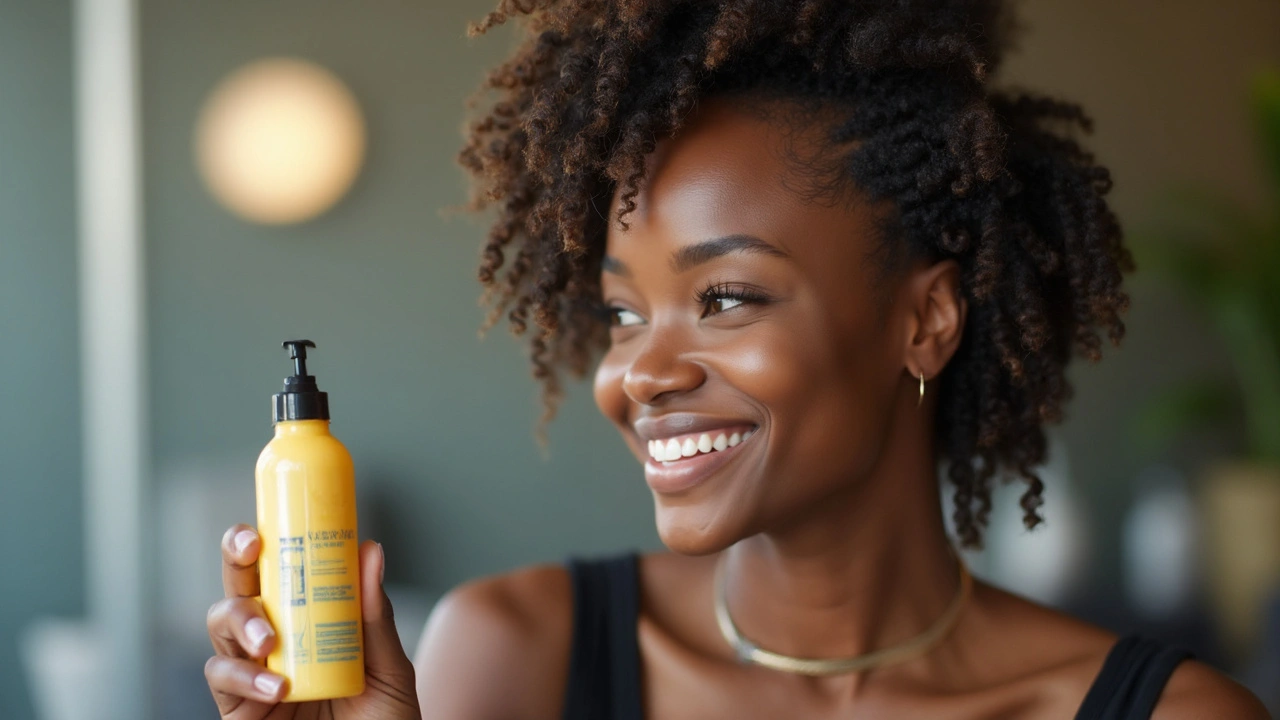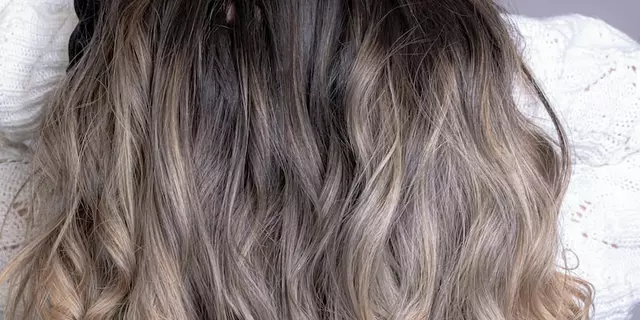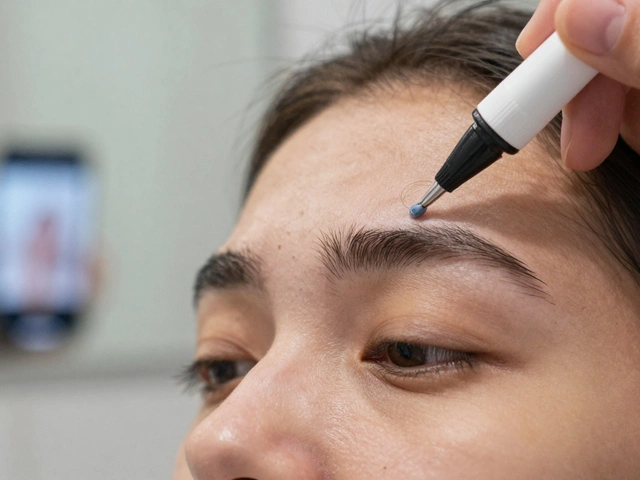Type 4C hair is one of the most misunderstood hair types, but there's nothing quite like its volume, texture, and flair. Until a decade ago, it barely got the spotlight it deserved, often tucked away under wigs or pressed flat to fit into mainstream beauty standards. Now, you see people rocking it on red carpets, magazine covers, and TikTok, sparking a movement of self-love and acceptance. What most folks don't realize is that 4C hair isn't just one look, and it definitely isn't 'unmanageable'. In fact, its versatility is mind-blowing, with countless ways to style, shape, and protect it.
What Exactly is 4C Hair? Breaking Down the Texture
Think of a tiny, tightly coiled spring—that's the hallmark of 4C hair. This curl pattern has very little defined curl when freshly washed or left unmanipulated. Every strand zigzags in sharp angles, making it prone to shrinkage (sometimes up to 75% of its length) and dryness. That makes it the most fragile of all hair types. The density? Wild. The volume? Out of this world. It's like cotton, soft but strong, and can pull off more shapes than most realize. The shrinkage isn't a curse—it's protection, letting each coil bounce back from tension and breakage. 4C natural hairstyles need the right products—think creamy leave-ins, shea butter, oils—to keep moisture locked in. Without that moisture, you might deal with breakage or tangling faster than with looser curls.
According to a 2023 survey from NaturallyCurly.com, around 16% of people with naturally curly hair identify their texture as 4C. Despite being the most prone to dryness, it's the least researched in beauty circles, which is wild considering it represents the hair of millions of Black women and men worldwide. Most hair product companies didn’t even address 4C needs until public demand exploded on social media, and platforms like YouTube are packed with creators showing their wash-day routines. Another fun fact: the 'C' in 4C doesn't mean 'coarse;' it's not about thickness, it's about how tight the curl actually is. You can have fine, medium, or thick 4C hair. The difference shows up more in styling than in hair strength.
If you’re still unsure about your hair type, a simple strand test works well: after washing your hair with no product in, gently stretch a small section. Is it tight like a pen spring and shrinks a lot? You’re probably seeing 4C in action. But, hair can be a mix of types, and that’s normal—it might be 4C at the crown and 4B at the nape.
The Best Protective 4C Natural Hairstyles
When folks talk about 4C hairstyles, the first thing that comes up is 'protective styling.' Why? 4C’s coils wrap around themselves, so they get thirsty fast and snap off if left exposed too long. Protective styles help by tucking the ends away, keeping them safe from friction, weather, and split ends. Here are some of the most-loved styles in 2025, with tips on getting the look to last and feel comfortable:
- Two-Strand Twists: Easy to do yourself, these twists can last weeks if you sleep with a satin bonnet. Add a little curl cream as you go, and seal with oil at the ends. The best part? You can untwist them for the ultimate twist-out look later.
- Bantu Knots: Not only are these super cute and retro, but after you take them down, they leave a killer curly pattern. Moisturize right before, and don’t make them too tight at the scalp or you could end up with tension headaches.
- Cornrows: Classic and low-maintenance, cornrows keep things tidy and creative. You can rock straight back rows, zigzags, or even add extensions for length. Just watch the tension around your edges. A spray bottle with water and leave-in always helps keep them fresh.
- Box Braids and Faux Locs: Perfect for anyone wanting a set-it-and-forget-it style. Synthetic hair adds protection but make sure not to overload your roots. Keep your scalp moisturized with light oils and don’t keep them in longer than eight weeks.
Want to try something bolder? Look up Fulani braids or goddess locs. For something super low effort, there’s nothing like a puff—just gather your hair at the top with a stretchy band and you’re good to go.
Here’s what a recent 4C hair routine usually looks like (according to a poll of 500 Type 4 hair owners in March 2025):
| Routine Step | Frequency |
|---|---|
| Moisturize & Seal | Every 2-3 Days |
| Wash & Deep Condition | Every 1-2 Weeks |
| Protective Styling | 3-4 Weeks at a Time |
| Scalp Massage | Once a Week |
| Trimming | Every 3-4 Months |
One tip most stylists swear by: don’t keep protective styles in too long. Scalp health matters just as much as length retention. And remember, the best style is the one that feels good—don’t pick a trend if it doesn’t fit your routine or your lifestyle.

Low-Manipulation Styles That Let 4C Curls Shine
Not every day calls for a protective style. Sometimes you just want to let your hair out and enjoy your coils. Here’s the thing: low-manipulation looks show off your texture but shouldn’t wreck your strands. The difference? Low-manipulation styles mean you’re not tucking, braiding, or pinning everything up, but you also aren’t yanking a comb through every morning. These styles make your curls the star.
- Afro Puff: Probably the easiest and most iconic style for 4C hair. Grab an elastic, pull your hair up, fluff a bit, and boom—a perfect puff. Add edge control for a sleek look or go wild with a halo of curls. Great for summer heat.
- Wash-n-Go: A bit of a misnomer for 4C people because it’s rarely just wash and go—usually involves gel, curling cream, and time. Once you master it, though, you get defined coils with a ton of volume. Use a diffuser if you’re pressed for time, but air-drying prevents frizz.
- Finger Coils: Tedious but worth it for those perfect corkscrew curls. After applying leave-in conditioner and gel, twist small sections around your finger and let dry. These curls last for days, and you get compliments everywhere you go.
- Twist-Outs and Braid-Outs: Start with freshly washed, damp hair, then twist or braid sections before bed. Take them out in the morning for big, fluffy, defined curls. Fluff roots with an afro pick for extra volume.
Want bigger and bolder? Try a blowout or use a pick to shape your afro. Just remember to use a heat protectant if you’re bringing out the blow dryer. People with 4C hair often say this is the style that gets strangers stopping them in the street to ask, ‘How did you get your hair like that?’
Moisture is key for all these looks, so stash a spray bottle of water and a go-to leave-in at all times. Silk or satin pillowcases at night reduce friction, so your styles last longer and you avoid waking up to a dry, fluffy mess.
Real Talk: Myths, Maintenance, and Tips for Healthy 4C Hair
You might have heard some wild stories about 4C hair—like that it can’t grow, is ‘unmanageable,’ or is just too much work. None of that holds up. The truth is, 4C hair just needs a specific kind of love. Growth is possible (you’ll find loads of YouTubers showing their waist-length 4C hair) as long as you focus on keeping it healthy, not just chasing length.
So, what works? Start with gentle detangling. Wide-tooth combs or your fingers are safest—never force a brush through knots. It helps to work in sections and always go from tip to root. Deep conditioning isn’t optional; it’s your hair’s favorite meal. Once a week with a protein-rich mask locks in strength and shine. And oils—don’t just slather them on. Use them to seal in moisture after you’ve hydrated your hair, not as a quick fix for dryness.
Don’t forget about scalp care. Clogged roots can slow down growth and cause itching. A once-a-week massage with jojoba or peppermint oil helps blood flow and feels amazing. If you use heavy butters, clarify with a cleansing shampoo every few weeks to avoid buildup.
Trimming doesn’t mean losing inches. Snipping off split ends every three months keeps your coils healthy and helps avoid bigger chop-downs later. Protective and low-manipulation styles should never be so tight they cause pain. If you feel tension, loosen up—the health of your edges and scalp is not worth a neat braid.
Got weak spots or breakage? Sometimes, it’s just a matter of switching up your routine or trying a silk-lined cap instead of regular hats. And if you want to try color, talk to a stylist who knows textured hair—bleach can dry 4C hair fast, so keep deep conditioners close.
The coolest part about 4C hair is its community. Social media like TikTok and Instagram are full of #4Chair hacks and real-life reviews from people actually using the products. If you’re stuck on a style or struggling with moisture, there’s always someone sharing tips that really work. Apps like Hair Pattern and CurlScan can even help you track the ingredients that your hair loves most.
Maybe the wildest fact? The hair that’s called ‘difficult’ is also the most versatile. The right routine and a few tricks let you switch from short, defined styles to huge afros or intricate braids overnight. It all starts with respect for your curl pattern—and getting creative with it every day.







Peter Reynolds
July 18, 2025 AT 06:40This post is a great resource for anyone struggling to understand 4C hair and how to care for it properly. The emphasis on protective styles is really important, especially since this hair type can be fragile. I appreciate that the article aims to bust myths rather than just list style ideas.
What I find really useful is the inclusion of tips from both real people and pros. It gives well-rounded guidance. Do you think there should be more focus on the role of moisturizing versus protein treatments? I’ve seen both recommended, but it’s often confusing.
Anyway, thank you for sharing this. It’s valuable info for a community that often doesn’t get enough tailored advice.
Fred Edwords
July 19, 2025 AT 21:33Excellent article! It’s refreshing to see a well-written and fact-checked guide on 4C hair. The detailed care tips combined with myth-busting really stand out. This hair type often suffers from misconceptions, so factual, precise advice helps combat those misunderstandings.
I'm particularly impressed with the focus on protective hairstyles. In my view, the best protective styles do not just preserve hair, but also respect hair's natural texture and health. The tips on routines are stellar, especially because consistency is key here.
For anyone new to 4C hair care, following these steps could really improve hair resilience. Kudos to the author!
Sarah McWhirter
July 20, 2025 AT 11:26Oh, great. Another “myth-busting” article. Because there aren’t already a million out there trying to dictate how we care for our 4C hair, right?
I mean, who decides what’s best? Industry experts and ‘real people’? Sounds a bit too coordinated if you ask me. There might be some hidden agendas in what’s touted as “best.”
Still, I do admit it’s nice to see some actual hacks that seem legit, but always take these things with a pinch of salt. Sometimes natural hair communities get monetized into obsession over routines and styles, which really just feeds certain businesses.
But hey, if it helps people feel confident, I guess it’s not all bad.
Ananya Sharma
July 20, 2025 AT 19:46Honestly, I believe these kinds of articles perpetuate stereotypes under the guise of helping. 4C hair doesn't need to be coddled more than any other hair type. The obsession with protective styling is overblown.
Protective styles aren't always the answer; they might even promote dependency on constant manipulation, weakening natural hair resilience. Care that respects hair’s natural health should be about balance, not overprotection or routine overload.
Plus, the cultural context is often missed in such guides. What works in the US or for certain demographics may not translate globally. All in all, a bit of a narrow viewpoint here.
kelvin kind
July 21, 2025 AT 15:13Nice breakdown. Really appreciate the concise care tips. Keeping hair healthy is about the basics, like moisture and gentle handling, which this article covers well.
It’s cool to see real people’s hacks included. Sometimes experts miss what actually works day to day for folks with 4C hair. The trending looks section was a nice touch, too, giving some inspiration without overcomplicating things.
Profiles like this are useful for anyone wanting to start exploring 4C styles without feeling overwhelmed.
Ian Cassidy
July 22, 2025 AT 19:00From a technical standpoint, the article merges practical advice with professional insight quite well. The jargon around hair porosity, shrinkage, and curl pattern is broken down into easy terms, so it's digestible even for those not familiar with the haircare lexicon.
Moreover, the guidance on the layering of products and the timing of treatments is crucial, as improper application can lead to buildup or dryness. This piece did well to highlight that nuance.
It might be helpful to include a bit more about how environmental factors like humidity or hard water affect 4C hair specifically.
Zach Beggs
July 23, 2025 AT 22:46I’ve got to say, this article hits the mark on understanding 4C hair nuances without being overwhelming. Often, advice can get really technical and turn people off, but here the tone is inviting and practical.
Also glad they touched on the importance of dispelling myths. Misinformation around 4C hair is everywhere, and it prevents many from embracing their natural hair beautifully.
Looking forward to trying out some of the protective styles mentioned and tweaking my routine based on the expert tips.
Kenny Stockman
July 25, 2025 AT 02:33Awesome post for those wanting to get serious about 4C hair care. One thing I'd add, from a coaching perspective, is that patience is key. Hair health improvements aren’t instant; it takes time to see what works.
Also, everyone’s hair journey is different, so experimentation within the protective styling and routine tips can help identify what’s best for you without frustration.
This article sets a solid foundation though. The real people hacks might be the most relatable part for many.
Anyone here tried protective styles that actually helped boost length retention?
Antonio Hunter
July 26, 2025 AT 06:20Drawing from my experience mentoring on natural hair care, I appreciate the balance struck here between advice for beauty and tips for health. 4C hair demands both because it is naturally more prone to dryness and breakage.
While styles are inspiring and boost confidence, the underlying maintenance—the care for scalp health, adequate moisture, and minimal manipulation—is crucial and well highlighted.
It might be valuable to see more diversity of hair care philosophies, too, perhaps contrasting 'no-poo' methods to conventional shampoo usage for 4C hair holders.
Overall, this piece is a solid step toward deeper understanding and community sharing.
Paritosh Bhagat
July 27, 2025 AT 10:06It’s always interesting to see how these guides present 4C hair with so much focus on routines and products—like it's complicated magic or some secret code. Honestly, sometimes it just needs simple love and less overthinking.
That said, the supportive tone here could empower newbies hesitant about embracing their hair texture. That’s the positive side.
But let’s not forget that haircare advice can sometimes morph into an emotional burden, making people feel they aren’t doing enough unless strictly following certain routines or styles.
Balance and self-acceptance are also critical, and that sometimes gets lost in translation.